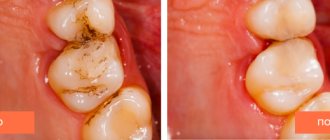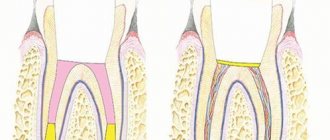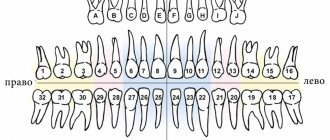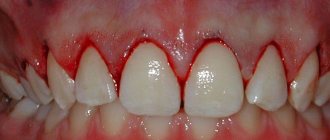Dental injuries are a common problem in dentistry. Tooth dislocation is an injury that results in damage to the ligamentous apparatus and the tooth being displaced in its socket (photo below).
Tooth dislocation is accompanied by:
- severe pain
- bleeding
- soft tissue swelling
- appearance of tooth mobility
- change in enamel color
The causes of such injury may be:
- mechanical damage (due to impact from a fall, for example);
- biting hard food, hard objects in food;
- bad habits (crunching nuts in the shell, opening bottles with your teeth, etc.);
The diagnosis of tooth trauma (including tooth dislocation) is made based on symptoms and x-ray examination. The doctor not only determines the clinical picture, but also assesses the condition of the bone tissue at the site of dental injury. Tooth dislocation has its own types (complete, incomplete, impacted) and treatment features.
Tooth dislocation: photos and symptoms
Any injury has its own clinical picture. Tooth dislocation, photos of which can be viewed on dental websites, is also characterized by specific symptoms. During the examination, the dentist looks for signs to diagnose a luxated tooth.
The doctor also determines what type of tooth dislocation the resulting tooth is. The symptoms of each are slightly different. After analyzing the x-ray, treatment is usually prescribed.
Types of injuries
Damage to dental tissue is acute and chronic. Acute injuries include bruise, crack, dislocation and tooth fracture.
Injury
A bruise is a closed injury and is characterized by darkening of the tooth and aching pain that intensifies when chewing. Sometimes, with bruises, damage to periodontal tissue is observed, leading to hemorrhages into the pulp chamber and death of the pulp.
Crack
It can be superficial or reach soft tissues, which determines the nature of the unpleasant sensations: from slight discomfort when chewing to severe pain when biting. The crack is invisible to the naked eye, so special fiber optic devices are used to make a diagnosis.
Types of tooth dislocations. Complete, incomplete and impacted tooth dislocation - what are the differences?
To determine what type of dislocation - complete, incomplete or impacted - the injury belongs to, you should pay attention to their differences in symptoms.
- Complete tooth luxation (photo below) is characterized by the tooth falling out of its socket. And if he is held in it, then only due to soft tissues.
- Incomplete tooth luxation is characterized by partial displacement of the root in the alveolus. Upon examination, it is noticeable that the tooth is tilted either towards the tongue, or back, or towards the cheek, or towards the lip.
- Impacted tooth dislocation is a rare type of such injury. With it, several teeth often suffer at once, which seem to go deep into the alveoli. An impacted tooth dislocation is visually recognized by a decrease in the height of its visible part (photo below). This injury leads to destruction of the jaw bone.
Complete tooth luxation, incomplete tooth luxation and impacted tooth luxation differ not only in symptoms, but also in the methods used in their treatment.
Tooth trauma: types, methods of treatment
Tooth trauma is a violation of the natural shape of a tooth or its displacement relative to its anatomical position. Dentists divide dental trauma into two general types: chronic and acute dental trauma.
Chronic tooth injury.
Chronic tooth trauma occurs when a weak traumatic factor acts for a long time. This form of damage is associated with unsafe habits (biting hard objects, opening bottles and caps with teeth, gnawing nuts and seeds), professional actions (seamstresses cutting thread, carpenters holding nails in their teeth, etc.). Chronic tooth trauma can also occur due to malocclusion or poor-quality prosthetics.
With constant mechanical impact on the teeth, the enamel wears away, chips and microcracks appear. If you do not take action, after some time pain will arise and your teeth will become more sensitive. Treatment boils down to eliminating the traumatic factor and restoring chips.
Acute tooth trauma.
Acute tooth trauma occurs when there is a sharp, simultaneous mechanical impact, which leads to a violation of the integrity of the tooth. Traumatic factors can be very different: injury during sports, at work, falls, blows to the jaw in a fight. Very often, such tooth trauma occurs in children. This is due to their increased activity. A child can damage a tooth by falling from a bicycle or swing.
There are several types of acute dental injuries:
Bruise - characterized by the fact that the tooth remains intact externally. Symptoms: aching, persistent pain, turning into acute pain when biting and chewing. If a bruise causes a bundle of blood vessels to be damaged and blood enters the pulp, the tooth at the base will turn pink or even turn red.
Treatment of bruise. The first rule is to provide rest to the bruised area: switch to ground liquid food, do not chew on the injured side, and do not touch the tooth with your hands. Physiotherapy is often prescribed. If the pulp is damaged, in order to avoid complications, the neurovascular bundle is removed (depulped).
Luxation is a displacement of a tooth in its socket. It may be accompanied by damage to the soft periodontal tissues. Symptoms: painful sensations, the tooth is loose or tilted. There are complete, incomplete, and impacted dislocations.
Treatment of dislocation. The sooner the victim consults a doctor, the greater the chance of avoiding removal. A tooth placed in place in time takes root well. After the operation, the patient’s tooth is fixed using splints. When treating a dislocation, the condition and degree of damage to the neurovascular bundle and root bone tissue play a decisive role.
A crack can be of varying degrees of severity - from light on the tooth enamel to deep with damage to the pulp. Cracks occur in both acute and chronic tooth trauma. Symptoms: pain - from a reaction to hot and cold, to acute pain when chewing and biting.
Crack treatment. If the crack is superficial, grind the opposite tooth to reduce the load on the damaged one. If the crack is deep and the pulp is damaged, the tooth will most likely have to be removed.
A fracture is an acute injury when part of a damaged tooth is torn off. Symptoms: severe pain, tooth mobility, visible damage. The fracture can be displaced or non-displaced. Depending on the location of the damage, a fracture of the neck, crown or root of the tooth is distinguished.
Treatment of a fracture. The diagnosis is made only after studying a photograph of the tooth. Next, depending on the nature and direction of the damage, the doctor decides: to remove the tooth or restore it by performing pulp removal and restoration.
Impacted, complete and incomplete tooth dislocation What treatment is needed?
Experts note that in most cases, injured teeth can be saved. The main thing is to see a dentist in time.
If an impacted tooth luxation is diagnosed, treatment is not always required, since the tooth often returns to its previous position on its own. But sometimes the damage is so severe that this does not happen. If just such an impacted tooth dislocation occurs, treatment is prescribed as for incomplete dislocation. Tactics for impacted dislocation can be different, it all depends on the degree of damage to the bone tissue and the severity of the injury.
If a tooth is completely dislocated, treatment should begin immediately. It is advisable to insert the fallen tooth into the hole and get to the dentist as quickly as possible. The tooth must be placed in milk or held behind the cheek. If the replantation of a tooth after a complete dislocation is done within 2 hours, then the tooth will be completely engrafted without any consequences.
Treatment for incomplete tooth dislocation consists of repositioning the tooth to its previous position, fixing it with a splint; if the pulp dies, the canal is treated and filled.
If you still can’t save the tooth, you can get prosthetics or implantation.
Restoration of teeth after injury by our experienced endodontists:
- extended warranty
- saving 79% of teeth with injuries of various origins
- painless restoration of tooth integrity on the day of treatment
- treatment using modern equipment under magnification and a microscope (fillings last 10-15 years or longer)
- high-quality diagnosis, not treatment by eye
- quality treatment at prices in the residential area of Yasenevo
Tooth dislocation in a child
Tooth luxation is a displacement of the crown in its alveolus as a result of physical impact. This injury is especially common in children and is common among all types of dental injuries. Symptoms of a dislocation may include:
- displacement of the dental crown back, forward, sideways
- the tooth is rotated around its axis
- the child cannot close his jaw completely
- tooth tissues are separated from the gums
- the soft tissue around the tooth swells and bleeds
- the tooth is loose, but still stays in the socket
It is imperative to see a dentist, even if the tooth looks almost undamaged. There may be a broken root or damaged nerve inside it. Such a tooth can be saved, the main thing is not to put pressure on it and not to self-medicate.
Only a qualified dentist can correctly assess the damage and prescribe effective treatment. If you see a doctor within the next hour after receiving an injury, the chances of saving the tooth increase significantly.
Forecast and prevention of dental injuries
Whether the tooth will be saved during treatment will depend on the type of damage itself, the time, and how timely the person consulted a doctor. Often, the state of a person’s general health and age are added to such criteria.
Today, modern methods of dentistry and orthodontics are so progressive that they help preserve their natural teeth, restoring them from damage even in the most complex cases of injury.
If the tooth still cannot be saved, then the doctor will suggest replacing it with an artificial option that has high functional and aesthetic characteristics.
Prevention of dental injuries will depend on the behavior and caution of the person himself, both at home and at work. When engaging in dangerous sports, a person should always use a protective helmet.
Classification
The modern classification of dental injuries includes several variants of acute cases, as well as chronic injuries. Let's take a closer look at the symptoms of each of them.
Acute injuries
Acute injuries mean a one-time mechanical impact that led to, , or. Most often, such injuries occur when sports equipment or other heavy objects hit the jaw. More details about each type of acute injury can be found in the articles of the same name.
Injury
This type of damage is characterized by constant aching pain in the tooth, which intensifies when chewing food or percussion. Sometimes, during a severe injury, a bundle of blood vessels ruptures. In this case, within a short period of time after the injury, due to blood entering the pulp, the enamel in the crown area may turn pink. Thus, if your tooth has darkened after an injury, the doctor will most likely diagnose a bruise. The condition of the soft tissues can only be determined after a couple of days.
Dislocation
Luxation means the displacement of a tooth relative to its original position in the socket. It is quite difficult to dislocate it in a healthy jaw, but with a painful periodontal condition and resorption of bone tissue, this type of damage is possible even when chewing hard food. With such a dislocation, there is a risk of injury to the soft tissue of the gums.
A dislocation can be identified by the painful sensations that occur in the area of one or more teeth during percussion. In addition, it is highly likely that the damaged tooth will be mobile. Doctors distinguish three types of dental dislocations: complete, incomplete and impacted dislocation.
Crack
Unlike a fracture, a crack does not tear off part of the damaged tooth, but the depth of the crack can be different, both superficial on the enamel and reaching the pulp. Accordingly, pain when chewing food with a damaged tooth will be different, from slight sensitivity to temperature changes to acute pain after biting.
In most patients, a crack is an acute injury to the teeth, however, in some cases it can also be chronic (due to incorrect position of the teeth, the habit of keeping foreign objects in the mouth). Also, the presence of a crack may be the result of improper treatment and the introduction of too large a tooth into the cavity.
Most often, a crack is very difficult to diagnose. It is not noticeable to the naked eye, and it is also practically undetectable on x-rays. Often, serious treatment is not required in the presence of a superficial crack that does not affect the pulp. If the crack is deep, reaching the very root, such a tooth must be removed.
Fracture
The main symptoms of a fracture are severe pain when chewing food, improper closing of the jaw, minor speech impediments, and often visible damage to the tooth itself. There are three types of fractures: neck fracture, crown fracture and root fracture. Such tooth trauma can only be diagnosed by radiography and poses the greatest danger, especially in the presence of dental splinters and debris.
Chronic injury
Unlike the acute form, chronic dental trauma does not occur immediately, but over a fairly long period of time. Most often, this form of damage is caused by bad habits (holding metal or other hard objects in the teeth) or professional behavior (biting thread or holding needles in the teeth by tailors, hooks and knitting needles by knitters, etc.). Prolonged mechanical impact on the enamel leads to thinning, chipping and other serious damage, which at some point causes severe pain due to tooth decay.









